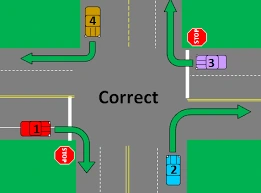The controlled intersections that are controlled are the pivotal points of the complex network of roads.
They are where traffic signs, signals and other devices are used to regulate the movement of vehicles.
What are controlled intersections ?
They are often located in areas with high traffic and urban environments. These intersections were designed to ensure safety and efficiency by facilitating a smooth, organized and safe flow of cars. Controlled intersections are important not just because they act as hubs for traffic but also because of their impact on the harmony of transport systems. Traffic lights and stop signs are just two of the many elements of controlled intersections that contribute to a coordinated orchestration designed to prevent collisions, minimize congestion and optimize the movements of road users.
Traffic signals are the central element of a controlled intersection. They’re iconic devices that, with their distinctive colors and patterns, dictate the flow and ebb of vehicular traffic. The red, green and yellow traffic lights are used as visual indicators to orchestrate the movement of pedestrians and drivers with an accuracy that is belied by the complexity of city traffic. Red lights signal a complete stop and a suspension of movement. Cross-traffic can continue safely. A green light signifies right-of-way, giving drivers permission to proceed through an intersection. A yellow light signals a change in direction and encourages drivers to either stop or proceed with caution. These signals are synchronized to ensure that vehicles do not cross paths at the same time.
The stop signs are another feature that is ubiquitous at controlled intersections. They help regulate traffic because they force drivers to stop moving. These octagonal signals are placed at specific points and serve as directives that require drivers to stop completely before continuing. The stop signs are placed strategically to deal with specific traffic patterns or potential conflicts and allow for safe vehicle convergence from all directions. Stop signs are universally recognized and have a language that is understood by all. The red octagon and its imperative wording, “STOP,” create an international standard of communication.
Controlled intersections are defined by more than just traffic signals and stop signs. The comprehensive set of rules that govern these traffic intersections includes yield signs, pavement markings and lane control. The yield signs are often triangular and signal drivers to give way to traffic coming from the opposite direction. It helps to improve predictability, prevent conflicts, and promote a smooth and cooperative flow of traffic. Crosswalks and lane markers are visual indicators that help drivers and pedestrians navigate the complex intersection. Traffic lane controls such as arrows or lane-specific signs help to refine traffic organization by directing vehicles into the correct lanes when turning, going straight, etc.

Controlled intersections have the primary objective of improving safety and reducing the risk of collision. Traffic signals and signs are strategically placed based on the geometrical shape of an intersection, speed and volume of traffic. Controlled intersections reduce the likelihood of an accident by imposing order on the chaotic interactions of road users. The controlled environment also benefits pedestrians. Crosswalks, signals for pedestrians and crossing zones provide a safe path to the intersection. This reduces the risk of collisions with vehicles.
Controlled intersections are also known for their efficiency, which is a result of the fact that they optimize traffic flow and decrease congestion. To achieve this, synchronizing traffic signals is an important strategy. The coordinated timing of signals ensures that traffic moves through intersections without stopping, which promotes a smooth and continuous flow of traffic. It not only increases the speed of traffic, but it also reduces emissions and improves fuel efficiency.
Controlled intersections have a greater impact on the functioning of the transportation system than just immediate traffic management. Integrated traffic control systems are often linked through the use of advanced technology. This allows for real-time monitoring and adapting to changing conditions. This responsiveness allows intersections to be agile and adaptable in response to changes in traffic, emergency situations, or other special events. Remote control of traffic signals and monitoring of them improves transportation network efficiency, allowing for a degree of flexibility in urban environments.
Conclusion
Controlled intersections play a crucial role in the management of complex road-user interactions. These intersections, from the traffic signals to the stop signs that are so iconic, embody regulations that prioritize order and safety. They contribute to overall transportation system functionality by coordinating signals, signs and other control devices in a harmonious manner. This reduces the likelihood of an accident, minimizes congestion and promotes a smooth flow of traffic. Controlled intersections remain central to the evolution of urban landscapes and the advancement of transportation technology. They adapt to the new challenges and continue to play a key role in orchestrating safe and efficient movement.
